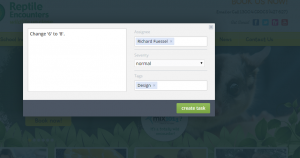
Tracking bugs and changes with any web project can be a real pain and often soaks up a huge amount of project management time. Many changes can be simple front end requests to your developer, such as images/buttons, fixing text alignment or changing font sizes. If you manage many web projects, you’ll know that these changes can be frustrating to track and manage -no one likes sifting through emails to determine what needs to be done, or using emails for back-and-forths with their developers.
Luckily, Australian software development agency Macropod Software have developed Bugherd, an online bug tracking and resolution tool which has changed our lives here at Salt & Fuessel! Bugherd is super easy to use, and has saved our team so much time tracking bugs, making what is often a tedious job (dare I say it) fun at times! If you haven’t had the pleasure of experiencing Bugherd, get involved!
The way the system works is simple, after installing a few lines of code on the site you are working on (you can even direct this task to your developer using the system), Bugherd is integrated into your website. When you are logged into Bugherd, a simple sidebar will visible to you on your website.
When you find a bug, either during development or after launch, it is as simple as clicking on the problem area and logging it right there and then. This takes the developer right to the problem area so there is no confusion, and allows attachments such as screen shots or videos. You can also add comments back and forth with the developer if anything needs to be cleared up.
The Bugherd process in a nutshell:
Step 1: Click the “plus” sign on the Bugherd Sidebar

Step 2: Highlight where on the page there is an issue:

Step 3: Detail to your developer what needs to be resolved. The bug can be tagged/categorised, and the severity of the bug (minor to critical) can be marked.

The central tracking and archiving system means that it is easy to prioritise bugs, moving them from “To Do” status until they are “Done” and can be marked as complete by the project manager. Clients can also log in to see progress and even log their own bugs if they are tech savvy.

We have tried several bug tracking tools in the past, eventually deciding on email which felt quickest. But since using Bugherd, we’ve been able to track and organise bugs in a seamless manner. Bugherd is now a core part of our development toolset and its superb user experience has meant that our team has picked it up very quickly.
We think that Bugherd is best in class and recommend that you give it a go. Happy bug tracking!

